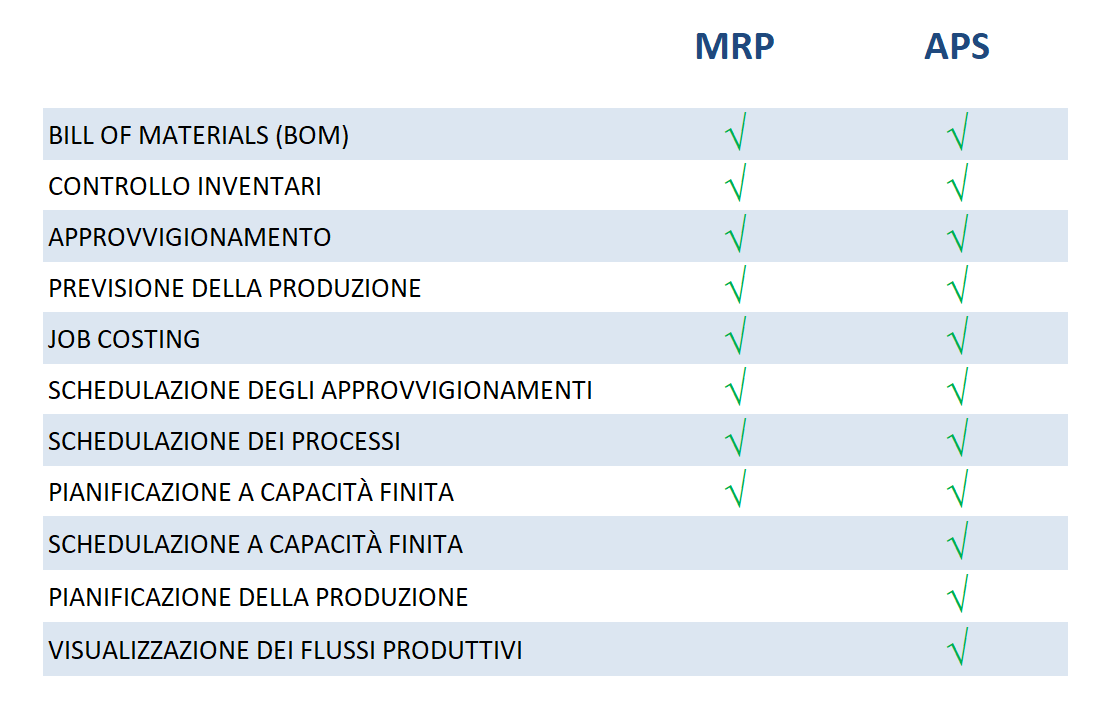In the current production scenario, which is becoming increasingly competitive, it is important to use technologies to pursue efficiency at every stage of the production process.
Implementing the right production control software, whether it is an MRP (Material Requirements Planning) or a software for production planning and scheduling, is particularly important when it comes to production scheduling. Both solutions serve to answer the 4 basic questions of production, namely:
- What do I produce?
- What do I buy?
- When do I buy?
- When do I produce?
Over the years, however, MRP and APS software providers have attempted to differentiate their solutions from those of competitors. This has created often confusing terminology regarding software terms. For example, there are two versions of MRP software: material requirements planning software (MRP I) and production resource planning (MRP II). At the same time, production planning and scheduling software is also called Advanced Planning and Scheduling software or APS. It is therefore easy to get lost or confused between these acronyms and solutions. This article helps clarify what these software applications actually do.
The features of MRP and APS software
It is useful to make a comparison between the functionalities of the MRPs and those of the production planning and scheduling systems.

Although both solutions help companies plan the resources needed for production, an advanced production planning and scheduling system is actually more advanced. In fact, APS-type software is based on more complex mathematical models and is on the whole a more sophisticated system. As you can see in the table, production planning and scheduling extends the capabilities of MRP in several ways.
MRP software plans materials
MRPs are among the oldest production software applications. Since its inception in the mid-1960s, the application has remained popular with manufacturing companies for several reasons: the main one is its ability to automate several key planning functions, such as inventory control and production forecasting. In addition, MRP offers manufacturing companies a certain level of production visibility for each type of production.
Of course, an MRP system performs more than simple inventory control and production forecasting functions: it covers everything from product ideation to production planning. For example, after a product has been designed, the system begins to plan and procure the parts needed to complete the work. During this process, the software automates key steps, such as:
- Determine what materials are available in inventory;
- Identify which materials need to be purchased (i.e. are not available in stock);
- Compare the time required to produce or purchase the components;
- Creating a production forecast to determine the total project time.
Material planning and procurement are well managed with MRP software in companies that have large volumes of similar products, or few products. In other words, this software is ideal for companies that have relatively predictable demand curves and little variation in products (such as a screw manufacturer). However, MRP has difficulty planning production in companies where order quantities change frequently or there are variations in the type of products manufactured. According to Carol Ptak, partner at the Demand Driven Institute, MRP systems encounter these problems because they assume that the plant’s capacity is unlimited or they are able to plan only a single production scenario. So even if production scenarios change, an MRP system will continue to place orders for production, even when there is no reason to produce at previously defined levels.
Planning and scheduling of production and allocation of resources
APS production planning and scheduling software was initially developed to address some of the shortcomings of MRP software. This type of software tries to create a more realistic program of when and how to produce, taking into account capacity limits. As Ptak noted, MRP and APS operate in synergy, with the distinction that the second software is more interested in operations, rather than materials.
APS production planning and scheduling software is designed to extend (and not replace) MRP functionality in four main ways. Specifically, the production planning and scheduling software:
- It uses finite capacity reasoning, that is, it takes into account the current production limits, while the MRP assumes that there are no constraints;
- It uses more complex algorithms to create different production scenarios, thus creating more accurate plans;
- It takes into account the delivery times required for the parts purchased from the outside, to have more precise and realistic project times;
- Prioritize according to profitability to ensure that the most important jobs are completed first.
Given the changing needs of companies that make complex products, it is essential that these companies have the ability to plan production dynamically. For example, most jobs at an aerospace company are of the ETO (Engineering To Order) type and require several components with production cycles that could last several months. These manufacturers may then have to produce many different products with low volumes. In this case, an MRP system may have difficulty accommodating production variations due to the need to update and adjust the calculations.
Like all software, however, these sophisticated planning systems can also have gaps. According to Carol Ptak, these systems always try to maintain maximum production capacity. Therefore, when a material is discarded, the system automatically assigns new work to machines in a workshop, which can lead to the production of goods that are not needed. It is therefore important to balance the pursuit of efficiency or profitability well when using production planning and scheduling software.
MRP or APS? Choosing the right application
As you can see, both MRP solutions and APS applications for production planning and scheduling make the planning process better and more efficient. However, the degree of detail that these two applications can handle is very different. To know which application is best suited for your business, it is important to understand your needs and requirements along with the capabilities of the software, now and in the near future.

